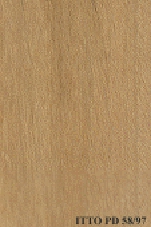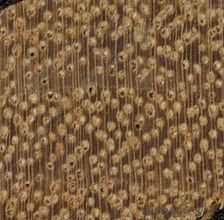
LOURO (Ocotea cymbarum)
Trade Name
Louro
Scientific Name
Ocotea cymbarum Kunth
Family
LAURACEAE
Common Names
Louro-Mamorim (Brazil); Louro-Japura (Brazil); Louro-Inamuí (Brazil); Louro-Imbaúba (Brazil); Louro-Gamela (Brazil); Louro-Consuelo (Brazil); Louro-Amarelo (Brazil); Louro (Brazil)
Scientific Name Synonyms
Ocotea barcellensis (Meisn.) Mez; Nectandra barcellensis Meisn.; Misanteca cymbarum (Kunth) Lundell; Licaria cymbarum (Kunth) Pittier
Description Of The Tree
Botanical Description
O. cymbarum is a big tree, it is reported to reach total heights of 20 to 30 m.
Natural Habitat
O. cymbarum is found in the Amazonian forest, in the varzea areas. The species occurs on the official list of threatened Brazilian plants compiled by IBAMA. Vulnerable(IBAMA,2001)
Natural Distribution
In Brazil it is reported in the basin of the rivers Negro and Solimoes, in Parana do Careiro and Maues.
Wood Identification
Anatomic Description Of Wood
Tyloses common. Vessel-ray pits larger than the intervessel pits. Intervessel pits large, 10 micras or more. Paratracheal axial parenchyma scanty and/or vasicentric. Occasionally heterogeneous rays and/or multiseriate heterogeneous rays. Oil and/or mucilage cells associated with the axial and/or ray parenchyma (idioblasts). Septate fibers present.
-
 Wood Macro Photo Tangential Plane
Wood Macro Photo Tangential Plane
-
 Wood Micro Photo Of Transversal Section
Wood Micro Photo Of Transversal Section
Availability
Cites Status
Unrestricted
General Wood Description
Odor
This species has a distinct smell and taste, especially when freshly cut.
Color
The heartwood is yellowish and the sapwood is lighter in color, but not clearly different from the heartwood.
COLOR INDEX (1=Black, 7=Light yellow,white)
4
Grain
Straight or interlocked grain is common in this species.
Texture
This species is reported to have a medium to coarse texture.
Luster
Luster is generally moderate to high.
Wood Physical Properties
Basic Density or Specific Gravity (O.D. weight/vol. green) (g/cm³)
0.66
Air-dry Density (Weight and volume at 12%MC) (g/cm³)
0.74
Total shrinkage Tangential (Saturated to 0%MC) (%)
8.1
Total shrinkage Radial (Saturated to 0%MC) (%)
3.9
Drying Defects
Ease of Drying: Drying is reported to be easy.
Dimensional stability ratio (Total Tangential Shrinkage %/Total Radial Shrinkage %)
2.1
Wood Chemical Properties
Wood Mechanical Properties
Bending Strength (MOR),12%MC (kgf/cm²)
1027
Compression parallel to fiber 12%MC (kgf/cm²)
565
Workability
Sawing
Cutting resistance is generally low.
Planing
Planing is reported to be easy.
Sanding
Sanding of this species is reportedly easy.
REFERENCED USES
End Uses Summary
HOUSING GENERAL, boards, PLYWOOD AND VENEER
General Housing
- 10 - Silica in Timbers
Boards
- 13 - Dry kiln schedules for commercial woods. Temperate and tropical. Section III. Latin American (Mexico, Central, and South America) Woods–Conventional Temperatures
Panels, Veneers
- 25 - Directory of Timber Trade Malaysia
Please Provide Information To View Producer Information